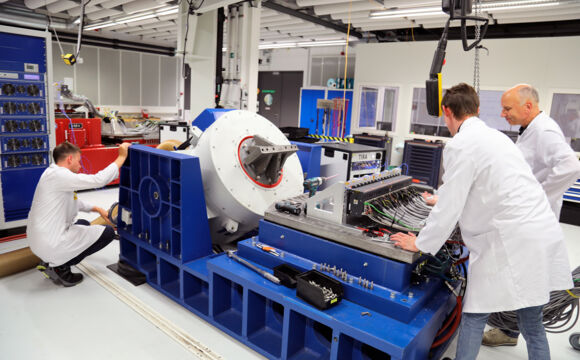“Indestructible” Product Quality
Bachmann challenges M100 system with shock and vibration tests
Bachmann systems can be found on presses, in the hubs of wind turbines, in driverless transport systems, on maritime vessels, or in exposed locations where they are subjected to significant vibration caused by strong winds. This is why the Austrian automation specialist has pushed shock and vibration tests to the limit during the development phase of its new M100 system.
Shock and vibration tests serve to demonstrate that a device can withstand the demands and stresses it may experience during its life cycle. Bachmann pushes these tests to their limit. Experimental shock loads of more than 40 times the acceleration of gravity (40 g) ensure reliability and availability in the harshest conditions. Control cabinets mounted on drive machines, or generators without complete mechanical separation, are exposed to constant vibrations. Bachmann systems are used on presses, in the nacelles of wind turbines, in driverless transport systems, on ships, and in very exposed locations where vibrations are caused by high wind turbulence. "This can be disastrous, especially at the point of contact," says Burkhard Martin, M100 I/O project manager at Bachmann.
Mechanical hardening
During the development phase, shock and vibration tests are used to expose all products to acceleration values far exceeding those reached in the real world. Exposure to such loads allows the detection and remedy of any weak points or defects in the design or components.
Pure stress
Modules undergo a whole series of grueling tests. These tests simulate loads and shocks of more than 40 times acceleration due to gravity (40 g). In another series of tests, each product must endure 1,000 shocks with an acceleration of 20 g in every spatial direction. In addition, vibration tests subject them to continuous vibration for around seven hours per axis at frequencies of 10 to 200 Hz. "And, even after that, the hardware doesn't fall apart; it continues to meet the performance requirements expected by our customers," says Martin.
Burkhard Martin is often asked why products are subjected to such high stresses, which are extremely unlikely to occur in the real world. "Compared to the service life of our products, the test phases are much shorter," explains the project manager. "Stressing hardware far beyond normal levels is comparable with greatly accelerated aging. Such tests therefore provide valuable information regarding general long-term stability." In principle, such robustness helps to extend service life and increase reliability, even in relatively standard locations. In addition, customers don't have much to do to make the installation location electronically suitable. They can also expect higher availability and fewer malfunctions. "And all of this leads to lower costs." Experimental shock loads of more than 40 times acceleration due to gravity (40 g) guarantee reliability and availability even under the most difficult conditions. In a lengthy series of tests, Bachmann modules are subjected to continuous stress through vibration and shock.
Robustness in detail
These tests resulted in many detailed improvements during the development phase of the M100 I/O System. Each individual module is installed in a robust and EMC-safe metal housing, which is securely attached to a stable rear panel with a vibration-resistant fixing. Cables are connected directly to the module via reliable, spring-loaded terminals, and connectors are equipped with a vibration-proof 'lock & release' mechanism. Bachmann can thus guarantee shock resistance up to 30 g, and vibration robustness up to 6 g.
A dependable reputation
Bachmann systems are renowned for their reliability and durability. Bachmann uses shock and vibration tests to identify potential problems – before devices are launched to the market. "This is how we continuously improve our product quality, which not only ensures that we meet the requirements of our various customer markets, but that we exceed them as well," concludes Burkhard Martin.






